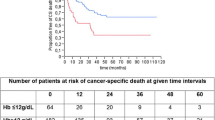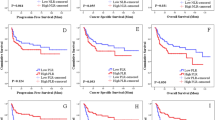Abstract
Purpose
Different blood parameters have shown to be associated with patient’s oncological outcome. There is only limited knowledge about the prognostic relevance of routine blood parameters in patients undergoing radical cystectomy for transitional cell carcinoma (TCC). Therefore, we retrospectively analyzed the influence of preoperative C-reactive protein (CRP) and hemoglobin (Hb) levels on overall survival (OS) and cancer-specific survival (CSS).
Materials and methods
Preoperative CRP and Hb levels were available in 664 patients who underwent RC due to TCC from 2004 to 2013 at our institution. More men than women (77 vs. 23 %) underwent surgery with a median age of 70 years (35–97). Median follow-up time was 24 months (max. 108). Outcome was analyzed using Kaplan–Meier method, log-rank test, and Cox regression models.
Results
Median CRP level was 0.5 mg/dl (0.1–28.3), and median Hb level was 13.4 g/dl (6.7–17.9). Patients with CRP value above the median died significantly earlier due to their disease than those with CRP below the median (median CSS 19 vs. 70 months; p < 0.001). Patients with preoperative Hb level below the median had significantly worse outcome than those with Hb level above the median (median CSS 25 vs. 78 months; p < 0.001). In multivariate analysis, CRP and Hb levels were independent prognostic parameters regarding CSS/OS (CRP p = 0.016/p = 0.004; Hb p = 0.006/p = 0.004, respectively).
Conclusions
In our single-center study, preoperative CRP and Hb levels were found to be independent prognostic factors, indicating impaired outcome in patients undergoing RC for TCC. These findings could be used for individual risk stratification and optimization of therapeutic strategies.




Similar content being viewed by others
References
American Cancer Society (2014) What are the key statistics about bladder cancer? http://www.cancer.org/cancer/bladdercancer/detailedguide/bladder-cancer-key-statistics
Gschwend JE, Dahm P, Fair WR (2002) Disease specific survival as endpoint of outcome for bladder cancer patients following radical cystectomy. Eur Urol 41(4):440–448
Trulson JJ, Sharma P, Haden T, Kheterpal E, Pokala N (2014) Comparative survival following different treatment modalities for stage T2 bladder cancer in octogenarians. World J Urol 32(2):425–429
Psutka SP, Carrasco A, Schmit GD et al (2014) Sarcopenia in patients with bladder cancer undergoing radical cystectomy: impact on cancer-specific and all-cause mortality. Cancer 120:2910–2918
Fussenich LM, Desar IM, Peters ME et al (2011) A new, simple and objective prognostic score for phase I cancer patients. Eur J Cancer 47(8):1152–1160
Stein B, Schrader AJ, Wegener G, Seidel C, Kuczyk MA, Steffens S (2013) Preoperative serum C-reactive protein: a prognostic marker in patients with upper urinary tract urothelial carcinoma. BMC Cancer 13:101
Morizane S, Iwamoto H, Masago T et al (2013) Preoperative prognostic factors after radical nephroureterectomy in patients with upper urinary tract urothelial carcinoma. Int Urol Nephrol 45(1):99–106
European Association of Urology (2014) Guidelines on Muscle-invasive and Metastatic Bladder Cancer. http://www.uroweb.org/gls/pdf/07MuscleInvasiveBC_LRLV2May14th.pdf
Kersten C, Louhimo J, Algars A et al (2013) Increased C-reactive protein implies a poorer stage-specific prognosis in colon cancer. Acta Oncol 52(8):1691–1698
Xu L, Zhao Q, Huang S, Li S, Wang J, Li Q (2014) Serum C-reactive protein acted as a prognostic biomarker for overall survival in metastatic prostate cancer patients. Tumour Biol 36:669–673
Hrab M, Olek-Hrab K, Antczak A, Kwias Z, Milecki T (2013) Interleukin-6 (IL-6) and C-reactive protein (CRP) concentration prior to total nephrectomy are prognostic factors in localized renal cell carcinoma (RCC). Rep Pract Oncol Radiother 18(5):304–309
Aziz A, Rink M, Gakis G et al (2014) Preoperative C-reactive protein in the serum: a prognostic biomarker for upper urinary tract urothelial carcinoma treated with radical nephroureterectomy. Urol Int 93(3):352–360
Fujita K, Uemura M, Yamamoto Y et al (2015) Preoperative risk stratification for cancer-specific survival of patients with upper urinary tract urothelial carcinoma treated by nephroureterectomy. Int J Clin Oncol 20(1):156–6314
Tanaka N, Kikuchi E, Shirotake S et al (2014) The predictive value of C-reactive protein for prognosis in patients with upper tract urothelial carcinoma treated with radical nephroureterectomy: a multi-institutional study. Eur Urol 65(1):227–234
Allin KH, Bojesen SE, Nordestgaard BG (2009) Baseline C-reactive protein is associated with incident cancer and survival in patients with cancer. J Clin Oncol 27(13):2217–2224
Heikkila K, Ebrahim S, Lawlor DA (2007) A systematic review of the association between circulating concentrations of C reactive protein and cancer. J Epidemiol Community Health 61(9):824–833
Okamoto M, Hattori K, Oyasu R (1997) Interleukin-6 functions as an autocrine growth factor in human bladder carcinoma cell lines in vitro. Int J Cancer 72(1):149–154
Coussens LM, Werb Z (2002) Inflammation and cancer. Nature 420(6917):860–867
DeNardo DG, Johansson M, Coussens LM (2008) Immune cells as mediators of solid tumor metastasis. Cancer Metastasis Rev 27(1):11–18
Weis SM, Cheresh DA (2011) Tumor angiogenesis: molecular pathways and therapeutic targets. Nat Med 17(11):1359–1370
Aggarwal BB, Gehlot P (2009) Inflammation and cancer: How friendly is the relationship for cancer patients? Curr Opin Pharmacol 9(4):351–369
Cui J, Zhou L, Wee B, Shen F, Ma X, Zhao J (2014) Predicting survival time in noncurative patients with advanced cancer: a prospective study in China. J Palliat Med 17(5):545–552
Gravis G, Boher JM, Fizazi K et al (2015) Prognostic factors for survival in noncastrate metastatic prostate cancer: validation of the glass model and development of a novel simplified prognostic model. Eur Urol 68:196–204
Gaspar BL, Sharma P, Das R (2015) Anemia in malignancies: pathogenetic and diagnostic considerations. Hematology 20(1):18–25
Langdon JM, Yates SC, Femnou LK et al (2014) Hepcidin-dependent and hepcidin-independent regulation of erythropoiesis in a mouse model of anemia of chronic inflammation. Am J Hematol 89(5):470–479
Icardi A, Sacco P, Tarroni A, Cappelletti L, Cozzolino M (2013) [Role of inflammation on renal anaemia]. Giornale italiano di nefrologia: organo ufficiale della Societa italiana di nefrologia 30(6)
Authors’ contribution
Tobias Grimm has been in charge of the project, managing the data collection, and has written the manuscript. Alexander Buchner has been in charge of data analysis and helped editing the manuscript.Alexander Kretschmer, Markus Grabbert, Birte Schneevoigt, Maria Apfelbeck, and Friedrich Jokisch helped with data collection and have been editing the manuscript.Christian Stief and Alexander Karl were in charge of project development and were responsible for the project.
Author information
Authors and Affiliations
Corresponding author
Rights and permissions
About this article
Cite this article
Grimm, T., Buchner, A., Schneevoigt, B. et al. Impact of preoperative hemoglobin and CRP levels on cancer-specific survival in patients undergoing radical cystectomy for transitional cell carcinoma of the bladder: results of a single-center study. World J Urol 34, 703–708 (2016). https://doi.org/10.1007/s00345-015-1680-7
Received:
Accepted:
Published:
Issue Date:
DOI: https://doi.org/10.1007/s00345-015-1680-7




